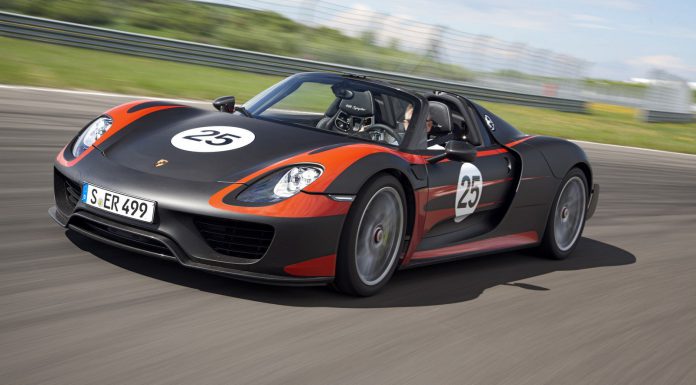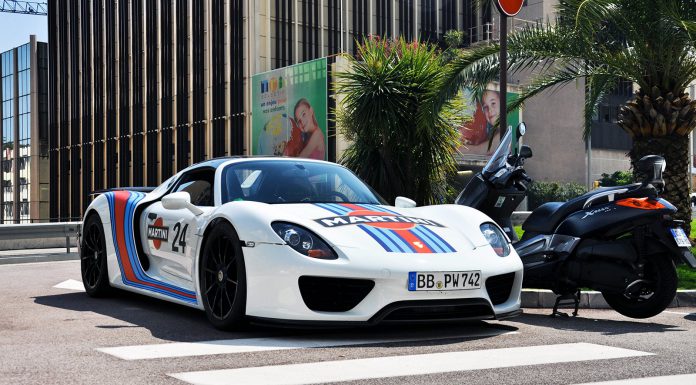Finally, one of the most awaited cars of the year has officially been released-the Porsche 918 Spyder. Unlike other supercars that premiered at the beginning of the year, the Porsche 918 Spyder has appeared severally on automotive news, starting with the prototypes to the final configuration model. But this does not mean it has lost the taste, in fact, the real experience is just about to begin with this new conception by Porsche.
It’s a hybrid super sports car that takes the hybrid technology to a whole new level; they developed this car from a clean sheet of paper, jointly with their race engineers and the production engineers. The project completes just in time when the Porsche 911 is celebrating the 50th anniversary. The Porsche 918 Spyder is highly inspired by Porsche’s racing knowledge, firstly, the race engineers who were involved in the project t are the same ones who are creating the 2014 Le Mans Porsche race cars.
Secondly, the concept of the V8 engine originates from the LMP2 RS Spyder race car, they even say that that the Porsche 918 Spyder can be driven without a body as its basis is a rolling chassis. The car features both a combustion engine and electric motors, integrated with the all-wheel drive system inspired by the 911 GT3 R Hybrid. The basic theory behind the 911 GT3 R Hybrid is that it stored its kinetic energy in a flywheel rather than the batteries.
In the Porsche 918 Spyder, the advanced “boost” strategy allows the driver to achieve maximum power since it manages the electric energy so efficiently; the driver only needs to press the accelerator down fully! The car has performed better than the Porsche Carrera GT on the Nurburgring setting a lap time of 7:14 minutes. Its fuel consumption is also better than most small cars in the market at 3 liters per 100km.
The Porsche will be powered by a 4.6 liter V8 engine producing 608hp and directly derived from the power unit of the previous RS successful. The engine features dry-sump lubrication with a separate oil tank and oil extraction. The air filter box and the air induction are all made of carbon fiber reinforced polymer to save on the weight not to mention the titanium connecting rods. Other lightweigh saving measures include the thin-wall, low-pressure casting on the crank case and the cylinder heads, a high-strength, lightweight steel crankshaft with 180 degrees crankpin offset and the extremely thin-walled alloy steel/nickel exhaust system.
The new weight optimization features have helped the Porsche 918 Spyder gain a power output per liter of 132hp/l which is the highest ever for a Porsche. The V8 no longer supports auxiliary systems-this means no more external driving belts. The 608hp power output is then supplemented by the parallel hybrid module which is made up of a 115 kW electric motor and a decoupler that serves as the connection with the combustion engine. The combined output is now 887hp and over 920lb-ft of torque!
The V8 is placed in front of the rear axle, and does not have any direct mechanical connection to the front axle. It’s mated to a 7-speed PDK transmission. The gear unit was turned “upside down” by rotating it 180 degrees about its longitudinal axis to ensure for lowest center of gravity, this is the first time it has happened in a Porsche. The other great feature in the engine is that when no power is required on the rear axle, the two motors can be decoupled by opening the decoupler and PDK clutches. In that way, you experience Porsche hybrid drive’s typical “coasting” with the combustion engine switched off.
At the front axle there is another electric motor which is rated at 95kW and drives the front wheels at a fixed ratio. To prevent this motor from over-revving, the decoupler decouples the electric motor at high speeds.
Porsche has introduced a new method in which exhaust gases are channeled and this has not been used by any other supercar. They did this through the ‘top pipes’ where tailpipes terminate in the upper part of the rear end immediately above the engine. In this manner, exhaust hot gases exit the engine through the shortest route possible allowing for low exhaust back pressure.
To do this they needed a new thermodynamic air channeling concept, the hot sides are in the inside the V of the engine while the intake channels are on the outside. This concept allows for a cooler environment in the engine under which the lithium-ion traction battery operates. The battery has 312 individual cells with energy content of about seven kilowatt hours and is liquid cooled by a dedicated cooling circuit.
Back to the basics, the Carbon monocoque guarantees lightweight design with a low centre of gravity and it has crash elements at the front and rear that The car has an unladen weight of approximately 1,640 kg while the drivetrain components and all components weighing over 50 kg are placed at a low and central place. This results to a rear end biased axle load distribution of 57 per cent on the rear axle and 43 per cent on the front axle.
There are lots of other exciting new features in this car, they include the rear-axle where the rear axle can be steered in the same direction as the front wheels or in opposition to them. While driving at lowe speeds, the system steers the rear wheels in a direction opposite to that of the front wheels hence cornering is more easy and direct. While driving at high speeds, the system steers the rear wheels in the same direction as the front wheels hence more stability.
Other features include the Porsche Active Aerodynamic (PAA) for different driving modes which include; the “sport” mode which allows for higher speeds, the spoiler is always extended in this mode while the aerodynamic flaps in the underfloor area close to reduce the aerodynamic drag. In “E” mode, the rear wing and spoiler are retracted and the underfloor flaps closed.
In “Race” and “Sport” modes; the intakes located below the headlights open to provide for maximum cooling while in “E-Power” and “Hybrid” mode they are closed to ensure low aerodynamic drag and will only open when the car goes above 130km/h.
There are five modes available for the Porsche 918 Spyder;
1. E-Power
This mode uses the battery as long as it’s well charged and will travel 30km on electric power reaching up to 150km/h and a naught to 100km/h in less than 7 seconds. The vehicle automatically switches to hybrid mode when the battery goes low.
2. Hybrid
This is a mode that uses the combustion engine while observing maximum efficiency and minimum fuel consumption.
3. Sport Hybrid
This mode is more dynamic, the combustion engine works had in hand with the electric motors for maximum power output.
4. Race Hybrid
This mode is similar to the Sport Hybrid mode only that now the engine is under high load and charges the battery when the driver is not using maximum output. The electric motors run at their maximum power output limit for a short time for better boosting, the battery undergoes charging hence electric power is available for longer periods of race laps.
5. Hot Lap
This mode can only be activated when the car is in Race Hybrid mode, the final reserves of the car are all released! This mode uses all the available power in the battery.
Lastly, the Porsche 918 Spyder will come with a Weissach Package which is optional. The package is optimized for higher performance and recognized through the race livery on it. The package comes with visible carbon parts as the roof, rear wings, rear-view mirrors and frames of the windscreen. The leather interior has been replaced with Alcantara in this package. The sound insulation has been reduced while it uses very lightweight magnesium wheels to reduce unsprung masses.
The driver and his passenger in this package will enjoy a motorsports-inspired interior with the six-point seatbelts. There is also an optional film-coating instead of the stock body paint and additional aerodynamic body parts in visible carbon.












































